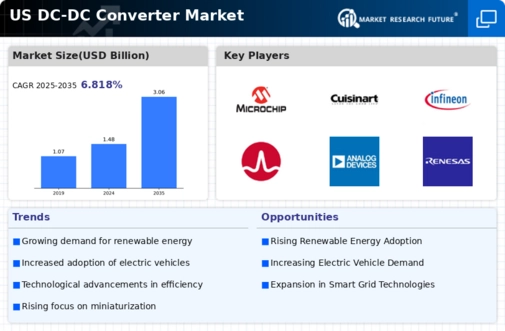Surge in Electric Vehicle Adoption
The increasing adoption of electric vehicles (EVs) in the US is a pivotal driver for the dc-converter market. As consumers and manufacturers shift towards sustainable transportation, the demand for efficient power management systems rises. DC-converters play a crucial role in EVs by converting battery voltage to the required levels for various components. According to industry estimates, the EV market is projected to grow at a CAGR of over 20% through 2025, which directly correlates with the rising need for advanced dc-converters. This trend indicates a robust growth trajectory for the dc-converter market, as manufacturers seek to enhance performance and efficiency in EV applications.
Regulatory Support for Energy Efficiency
Regulatory support for energy efficiency initiatives in the US is a driving force behind the dc-converter market. Government policies aimed at reducing energy consumption and promoting sustainable practices encourage the adoption of energy-efficient technologies. DC-converters, known for their ability to minimize energy loss during power conversion, are increasingly favored in various applications. The US Department of Energy has set ambitious energy efficiency standards, which are expected to drive the market for dc-converters as industries seek compliance. This regulatory environment suggests a favorable outlook for the dc-converter market, as businesses invest in technologies that align with energy efficiency goals.
Increased Demand for Portable Electronics
The rising demand for portable electronics in the US is a significant driver for the dc-converter market. As consumers increasingly rely on smartphones, tablets, and wearable devices, the need for efficient power management solutions becomes critical. DC-converters are essential for optimizing battery life and performance in these devices. Market Research Future indicates that the portable electronics segment is expected to grow at a CAGR of 10% through 2025, further emphasizing the importance of dc-converters in meeting consumer expectations for longer-lasting and more efficient devices. This trend highlights the potential for growth within the dc-converter market as manufacturers adapt to evolving consumer needs.
Expansion of Renewable Energy Infrastructure
The ongoing expansion of renewable energy infrastructure in the US significantly influences the dc-converter market. As solar and wind energy installations proliferate, the need for efficient power conversion systems becomes paramount. DC-converters are essential for integrating renewable energy sources into the grid, ensuring optimal energy flow and management. The US Department of Energy reports that renewable energy accounted for approximately 20% of total electricity generation in 2025, highlighting the increasing reliance on these technologies. This growth in renewable energy adoption is likely to drive demand for dc-converters, as they facilitate the effective utilization of generated power.
Technological Innovations in Power Electronics
Technological innovations in power electronics are reshaping the landscape of the dc-converter market. Advancements in materials, such as wide bandgap semiconductors, enhance the efficiency and performance of dc-converters. These innovations allow for smaller, lighter, and more efficient designs, which are increasingly sought after in various applications, including telecommunications and industrial automation. The market for power electronics is expected to reach $50 billion by 2026, indicating a strong growth potential for dc-converters as they become integral components in modern electronic systems. This trend suggests that ongoing research and development will continue to propel the dc-converter market forward.





















Leave a Comment